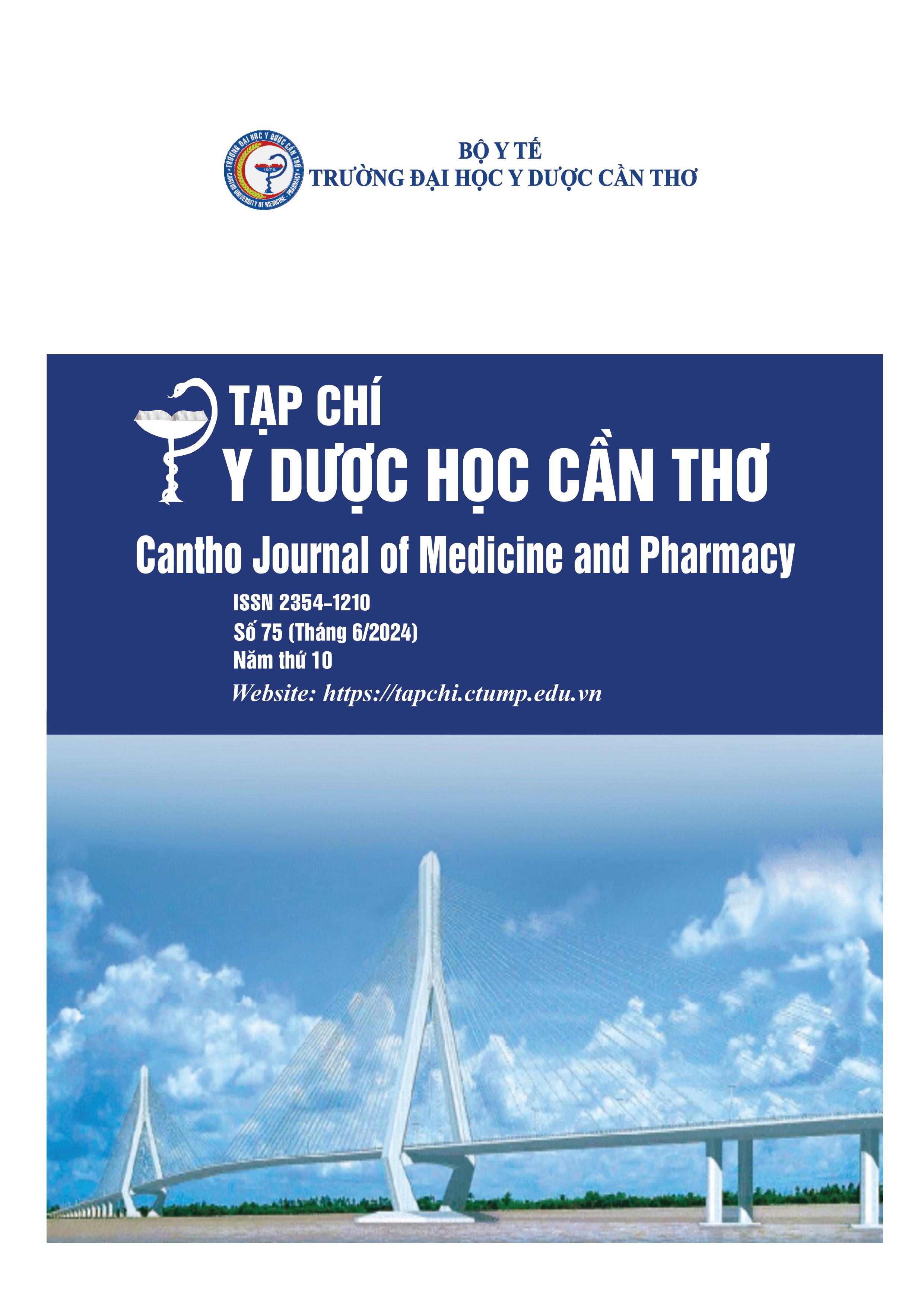PROGNOSTIC VALUE OF THE RATIO OF LACTATE TO ALBUMIN IN PREDICTING MORTALITY IN CHILDREN WITH SEPTIC SHOCK AT CAN THO CHILDREN'S HOSPITAL IN 2022-2024
Main Article Content
Abstract
Background: The lactate/albumin ratio is considered a valuable marker for predicting mortality in patients with septic shock. However, most studies on this topic have been conducted in adults, and there is a lack of data on this index in Vietnam. Objectives: 1). To describe the clinical, paraclinical characteristics and mortality rate in children with septic shock at Can Tho Children's Hospital; 2.) To determine the prognostic value of the lactate/albumin ratio for mortality in children with septic shock. Materials and methods: This was a descriptive cross-sectional study with case series analysis of 32 children diagnosed with septic shock at Can Tho Children's Hospital from July 2022 to February 2024. Results: Among the 32 children with septic shock who met the inclusion criteria, 53.1% were male and 34.4% were infants. The main route of infection was the gastrointestinal tract (56,3%). The positive blood culture rate was 21,9%. The mortality rate was 56.3%, with 6.3% of the children dying within 24 hours of being diagnosed with shock. Compared to the surviving group, the non-surviving group exhibited significantly higher lactate and lactate/albumin levels, while albumin levels were significantly lower (p < 0.001). For predicting mortality in children with septic shock, the area under the receiver operating characteristic (ROC) curve (AUROC) for the lactate/albumin ratio was 0.89 (95% CI: 0.78-1.00), with a cut-off point of 1.6 (sensitivity: 88.9%, specificity: 78.6%). The AUROC for lactate alone was 0.88 (95% CI: 0.76-1.00), with a cut-off point of 3.9 (sensitivity: 94.4%, specificity: 71.4%). The lactate/albumin ratio had lower sensitivity but higher specificity than lactate alone. Conclusion: The mortality rate of children with septic shock at Can Tho Children's Hospital is high and the lactate/albumin ratio provides very good prognostic value for mortality in children with septic shock.
Article Details
Keywords
Lactate/albumin ratio, lactate, albumin, mortality, septic shock
References
2. Jat K.R., Jhamb U., Gupta V.K. Serum lactate levels as the predictor of outcome in pediatric septic shock. Indian Journal of Critical Care Medicine : Peer-reviewed, Official Publication of Indian Society of Critical Care Medicine. 2011.15(2), 102-107. https://doi.org/10.4103/09725229.83017.
3. Kim Y.S., Sol I.S., Kim M.J., Kim S.Y., Kim J.D., et al. Serum Albumin as a Biomarker of Poor Prognosis in the Pediatric Patients in Intensive Care Unit. Korean Journal of Critical Care Medicine. 2017.32(4), 347-355. https://doi.org/10.4266/kjccm.2017.00437.
4. Bou Chebl R., Jamali S., Sabra M., Safa R., Berbari I., et al. Lactate/Albumin Ratio as a Predictor of In-Hospital Mortality in Septic Patients Presenting to the Emergency Department. Frontiers in Medicine. 2020.7. https://doi.org/10.3389/fmed.2020.550182.
5. Yoon S.H., Choi B., Eun S., Bae G.E., Koo C.M., et al. Using the lactate-to-albumin ratio to predict mortality in patients with sepsis or septic shock: a systematic review and meta-analysis. European Review for Medical and Pharmacological Sciences. 2022.26(5), 1743-1752. https://doi.org/10.26355/eurrev_202203_28244.
6. Shin J., Hwang S.Y., Jo I.J., Kim W.Y., Ryoo S.M., et al. Prognostic Value of The Lactate/Albumin Ratio for Predicting 28-Day Mortality in Critically ILL Sepsis Patients. Shock (Augusta, Ga). 2018.50(5), 545-550. https://doi.org/10.1097/SHK.0000000000001128.
7. Goldstein B., Giroir B., Randolph A., International Consensus Conference on Pediatric Sepsis. International pediatric sepsis consensus conference: definitions for sepsis and organ dysfunction in pediatrics. Pediatric Critical Care Medicine: A Journal of the Society of Critical Care Medicine and the World Federation of Pediatric Intensive and Critical Care Societies. 2005.6(1), 2-8. https://doi.org/10.1097/01.PCC.0000149131.72248.E6.
8. Trần Minh Dung, Phùng Nguyễn Thế Nguyên. Albumin máu ở trẻ sốc nhiễm khuẩn tại Bệnh viện Nhi đồng 1. Tạp chí Y học Thành phố Hồ Chí Minh. 2019.23, 67-74.
9. Hazwani T.R., Kazzaz Y.M., Alsugheir S., Aldelaijan S., Alsugheir F., et al. Association Between Culture-Negative Versus Culture-Positive Sepsis and Outcomes of Patients Admitted to the Pediatric Intensive Care Unit. Cureus. 12(8), e9981. https://doi.org/10.7759/cureus.9981.
10. Hà Thanh Hiếu, Bùi Quang Nghĩa, Lê Hoàng Sơn. Đặc điểm lâm sàng, cận lâm sàng và đánh giá kết quả điều trị nhiễm trùng huyết ở trẻ tại bệnh viện nhi đồng Cần Thơ năm 2018-2020. Tạp chí Y Dược học Cần Thơ. 2020.(29), 66-72.
11. Nguyen P.M., Phan H.V., Vo-Pham-Minh T., Tran A.V., Nguyen T.T., et al. Comparing Pediatric Index of Mortality 3, Pediatric Logistic Organ Dysfunction 2 (PELOD-2), and Modified PELOD-2 scores for Mortality Prognosis in Vietnamese Children with Multiple Organ Dysfunction Syndrome. Journal of Health Science and Medical Research. 2022.41(1), e2022890. https://doi.org/10.31584/jhsmr.2022890.
12. Wang G., Liu J., Xu R., Fu Y., Liu X. Lactate/albumin ratio as a predictor of in-hospital mortality in critically ill children. BMC Pediatrics. 2022.22(1), 725. https://doi.org/10.1186/s12887-02203787-0.


